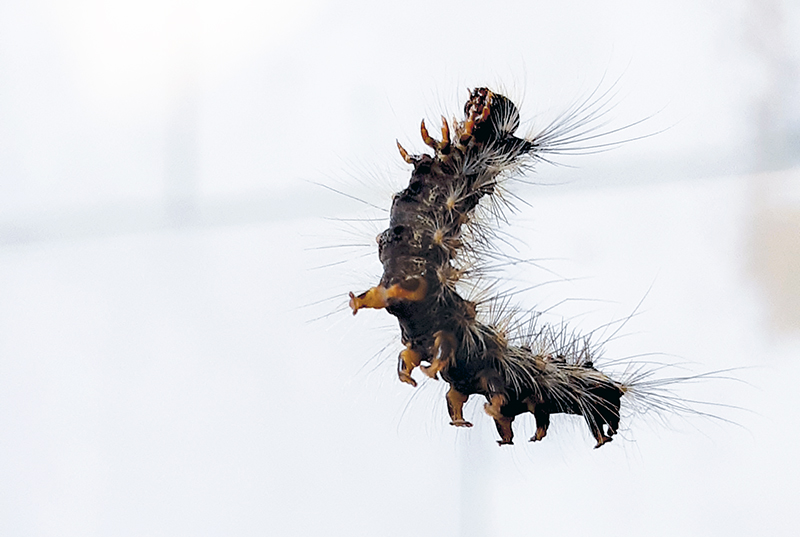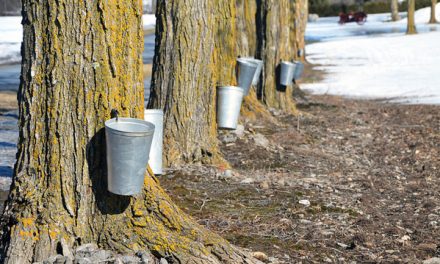The gypsy moth caterpillars crawl on the ground and trees, also they can travel in the air through a process called ballooning (dangling in mid air) as shown in the photo. Al-Rajab Photo
As you are reading this article, more trees and shrubs are being chewed by gypsy moth caterpillars. Gypsy moth outbreaks occur every seven to 10 years, and high infestations of this pest were reported this summer in different regions of Ontario.
Defoliation caused by gypsy moth in Ontario increased from 47,203 hectares in 2019 to 586,385 hectares in 2020 as reported by the Ontario Ministry of Natural Resources and Forestry. There is no available data yet for 2021’s defoliation.
The gypsy moth (Lymantria dispar dispar, Lepidoptera: Erebidae) is native to Europe and was first detected in Ontario in 1969. The larvae chew holes in leaves or devour entire leaves of the host plants such as oak (Quercus), birch (Betula), aspen (Populus), sugar maple (Acer saccharum), American beech (Fagus grandifolia), eastern white pine (Pinus strobus), balsam fir (Abies) and Colorado blue spruce (Picea pungens). During severe outbreaks, trees and shrubs are completely defoliated over large areas; despite the trees’ ability to produce a new crop of leaves over the summer, the damage causes significant growth loss. The gypsy moth is a regulated pest by the Canadian Food Inspection Agency (CFIA) which is responsible for establishing and maintaining standards to prevent the introduction and spread of plant pests in Canada.
Identification and life cycle
The gypsy moth has four development stages: egg, caterpillar, pupa, and moth. Caterpillars are 5-6 centimetres long, with five pairs of blue dots and six pairs of bright red dots along their back. Female moths are white with dark markings and cannot fly. Male moths are brown and can fly.
Females are larger than males with a 5 cm wingspan, males’ wings only span 2.5 centimetres. Egg masses are about 4 cm long, tan coloured, and can be found on tree trunks, furniture, buildings, etc. The insect spends winter in the egg stage often on the bark of trees. In spring, eggs hatch and larvae ascend the trees to feed on the new foliage. Initially, feeding occurs during the day, but as the caterpillars mature feeding occurs mainly at night.
How to control Gypsy moth?
Forest health is monitored every year by the Ontario Ministry of Natural Resources and Forestry. However, a localized approach could be taken to manage gypsy moths on a private property. Each control option will depend on the gypsy moth life stage and the time of year. For instance:
- Early stage of caterpillar (mid-April to mid-May): control by application of biological pesticides such as BTK. Bacillus thuringiensis (Bt) is a bacterium found naturally in the soil. It is known to cause illness in many insect larvae, including caterpillars of pest species such as gypsy moth, spruce budworm and cabbage looper. More than 20 varieties of Bt exist. The “kurstaki” variety (Btk) is used to control caterpillars. Bt pest-control products have been registered for use in Canada for over 30 years.
- Late stage of caterpillar (mid-May to June): attach burlap bands and discard larvae. Some townships giveaway free burlap kits to help trap and control gypsy moth caterpillars. The burlap kits are wrapped around tree trunks to trap caterpillars as the insects move up and down the tree.
- Pupae (June to July): remove by hand and discard.
Otherwise, natural predators and pathogens exist in nature and control the population of gypsy moth, such as:
- Nuclear polyhedrosis virus (NPV) which is a viral infection known to kill gypsy moth larvae once the virus builds up in a population. It can spread quickly from infected larvae to non-infected larvae, killing them. Dead larvae hanging on a tree in an upside-down “V” is a sign that the virus is at work in the population.
- Entomophaga maimaiga: a fungus known to cause gypsy moth populations to collapse. Cool, wet conditions provide an ideal environment for the spread of this fungus. Dead larvae hanging vertically along tree trunks that appear brittle and desiccated is a sign that this fungus has killed gypsy moth larvae.
- Predation and parasitism: birds, mammals and other insects are known to prey on the gypsy moth.
A species of wasp called Ooencyrtus kuvanae is known to parasitize gypsy moth eggs and can reduce gypsy moth populations.
- Cold weather: extended days of extreme cold (−20 degrees Celsius) may kill overwintering larvae in exposed egg masses.













